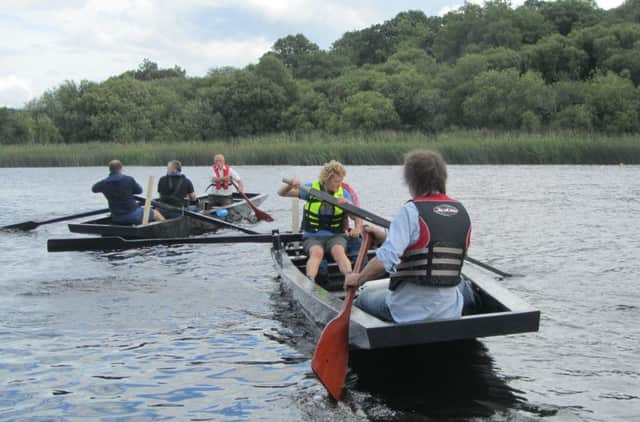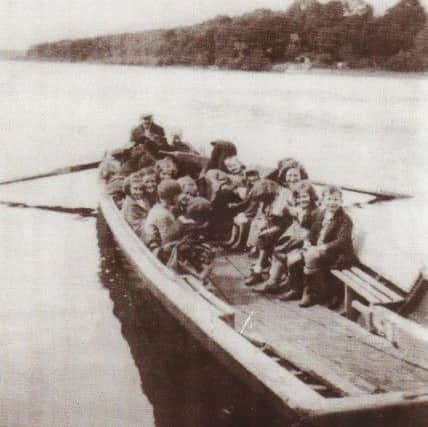Proving that we've still cot what it takes to make sporting history


Rio’s games hailed from Greece sometime around 776 BC.
Lough Erne Heritage organisation’s regatta last Saturday was billed as “a demonstration of how cot and rowing-boat racing might have taken place in the 1800s” and Ireland’s wooden cots were probably in use 2,000 years earlier!
Fred Ternan, one of the Fermanagh heritage group’s leading lights, shared some of the long history of Lough Erne’s cots on this page last year, providing us with a copy of an old letter dated August 12, 1824.
Advertisement
Hide AdAdvertisement
Hide Ad

“It’s the earliest reference to cot racing I have been able to find so far,” he explained.
The almost 200-year-old document referred to a number of Donegal oarsmen competing against Fermanagh’s local cot racers.
“The stir visible amongst the seamen of the Lake assures a most interesting contest,” the letter recounted, continuing “as well as the unrivalled beauty of the sailing ground….the boats, some of which, built on the Thames, are considered to be superior to any other vessels of any size, for lake sailing.”
Last Saturday’s historic boating event was the first ever re-enactment of a famous cot race held at Crom Castle in August in 1856.
Advertisement
Hide AdAdvertisement
Hide Ad

The winners 160 years ago were presented with a cash prize by Crom’s Lord Erne, but they declined to accept it, asking instead for the Earl of Erne to arrange for the homecoming of a Parish Priest exiled in America.
Father Clarke had officiated at a mixed marriage in Newtownbutler “which apparently was illegal in those days”
Mr Ternon explained. “The priest was going to be arrested but was ‘tipped off’ by a friendly policeman. Dressed as a tramp, he escaped to America,” Fred added. Lord Erne’s intervention was successful and Father Clarke was allowed to return to Newtownbutler where he served out his days in the parish.
“Plays, poems and songs have been written about this,” Fred explained.
Advertisement
Hide AdAdvertisement
Hide Ad

Music and drama also featured at Saturday’s commemorative regatta, held in in conjunction with the Erne heritage group, the Cavan Men’s Shed (a community activity group) and Newtownbutler Historical Society.
The cots were launched by Lord Erne and Michael Goodwin.
“Michael and his brother Peter came with their wives from Dublin for the day,” Mr Ternon recounted, adding “they are descendants of John Goodwin who rowed the winning cot in the famous race of 1856.”
Prior to Saturday’s event there was a play in Crom Castle’s visitors centre - “a great time of storytelling, acting and song,” Fred told me.


“It rained on Saturday morning,” he added. “But after lunch the weather cleared and the sun shone on us during the entire afternoon!”
Advertisement
Hide AdAdvertisement
Hide AdRace-official Gabriel Fitzpatrick laid out the course in front of Crom’s visitor centre.
The 1856 race started at the old castle’s boathouse, but due to Saturday morning’s bad weather, the organisers relocated the race course closer to cover!
The starting and finishing points were watched over by Gabriel and John Sey, the latter in a big Crom cot loaned by Lord Erne.
Members of the Cavan Men’s Shed organised the crew changeovers, which “was a very slick process indeed” Fred
commended.
Advertisement
Hide AdAdvertisement
Hide AdThe Olympic Games that ended in Rio at the weekend were a modern, greatly-expanded version of the ancient Greek games.
Today’s modernised Olympic Games were first held in Athens in 1896, though in 1850 an ‘Olympian Class’ event was held in Wenlock in Shropshire, an annual sports festival that still continues.
The early Wenlock competitions included athletics and traditional country sports like quoits, cricket and wheelbarrow races.
There was even a race for elderly ladies where the prize was a pound of tea! Over 10,000 athletes, representing 207 nations, competed in 31 different kinds of sport in Rio’s Olympics.
Advertisement
Hide AdAdvertisement
Hide AdWenlock’s first games, and Lough Erne’s early cot races, were infinitely smaller than Rio, but nonetheless required a great deal of organisation.
And Saturday’s re-enactment at Crom Castle of the famous 1856 race also needed more than a little nautical know-how!
Entrants had to comply with detailed directions given by race officials; buoyancy/life jackets had to be worn; all entrants competed “entirely at their own risk” and the official entry form stated “rowing experience is necessary, and terms and conditions will apply.”
As well as officials at the starting and finishing lines, there were folk responsible for registration, score keeping, and handing the boats over from one crew to the next.
Advertisement
Hide AdAdvertisement
Hide AdEight racing-teams took part, with a knock-out system ending in semi-finals, finals and special men’s and ladies’ races. The grand-finale ‘1856 Commemorative Cot Race’ was crewed by volunteers. Lough Erne’s unique boating legacy was demonstrated by one of the winning ladies, Josie Mohan, who’d been brought up on one of the vast waterway’s many islands.
“She displayed a great style of rowing,” said an official. And the winning men’s team consisted of three young
Fermanagh men - Lloyd Seaman, Cormac McLaughlin and Alex McElroy - who began rowing at Portora Boat Club “and
have since rowed to a very high standard in England and Ireland winning gold in Wales,” Mr Ternan told me.
Advertisement
Hide AdAdvertisement
Hide AdIn his opening speech at the event, Lord Erne recalled the importance of cots around Crom castle, where the boats were used for attending church, for travelling to his sisters’ weddings, and sadly, at his father’s recent funeral, across the Lough by cot to Derryvore Church.